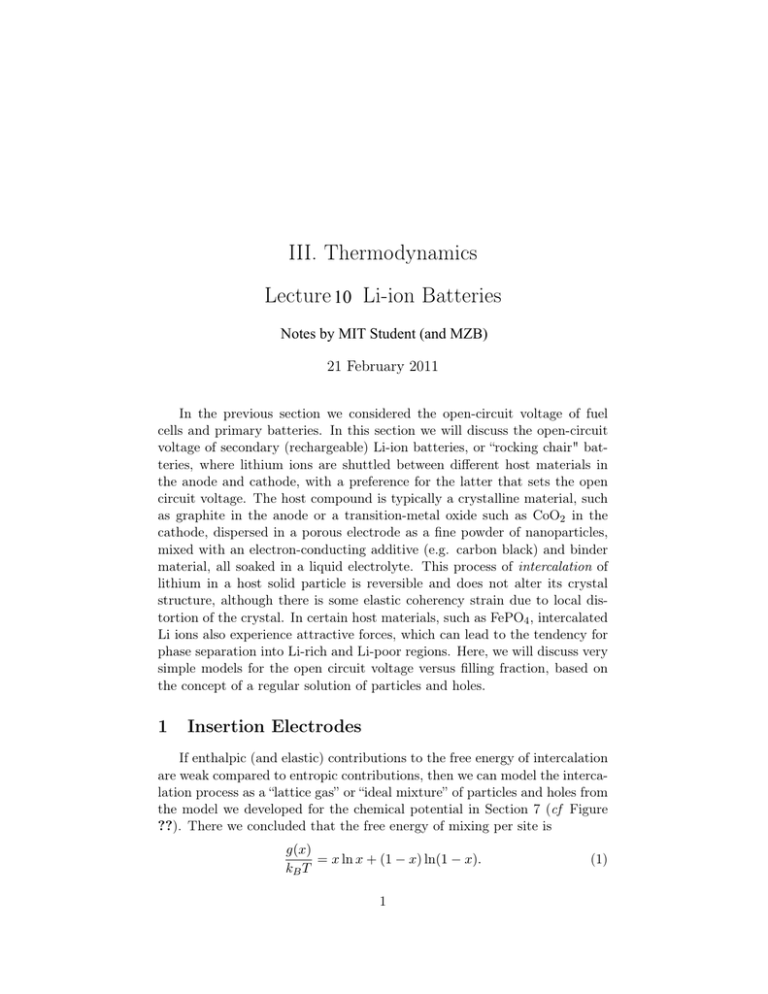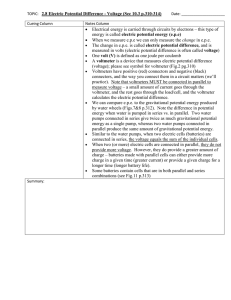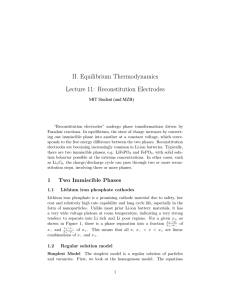Thermodynamics III. Li-ion Batteries Lecture
advertisement

III. Thermodynamics Lecture 10 Li-ion Batteries Notes by MIT Student (and MZB) 21 February 2011 In the previous section we considered the open-circuit voltage of fuel cells and primary batteries. In this section we will discuss the open-circuit voltage of secondary (rechargeable) Li-ion batteries, or “rocking chair" bat­ teries, where lithium ions are shuttled between different host materials in the anode and cathode, with a preference for the latter that sets the open circuit voltage. The host compound is typically a crystalline material, such as graphite in the anode or a transition-metal oxide such as CoO2 in the cathode, dispersed in a porous electrode as a fine powder of nanoparticles, mixed with an electron-conducting additive (e.g. carbon black) and binder material, all soaked in a liquid electrolyte. This process of intercalation of lithium in a host solid particle is reversible and does not alter its crystal structure, although there is some elastic coherency strain due to local dis­ tortion of the crystal. In certain host materials, such as FePO4 , intercalated Li ions also experience attractive forces, which can lead to the tendency for phase separation into Li-rich and Li-poor regions. Here, we will discuss very simple models for the open circuit voltage versus filling fraction, based on the concept of a regular solution of particles and holes. 1 Insertion Electrodes If enthalpic (and elastic) contributions to the free energy of intercalation are weak compared to entropic contributions, then we can model the interca­ lation process as a “lattice gas” or “ideal mixture” of particles and holes from the model we developed for the chemical potential in Section 7 (cf Figure ??). There we concluded that the free energy of mixing per site is g(x) = x ln x + (1 − x) ln(1 − x). kB T 1 (1) Lecture 10: Li-ion batteries 10.626 (2011) Bazant Figure 1: A lattice of particles and holes representing intercalated lithium ions and vacancies in a host crystal. The diffusional chemical potential is then µ(x) 1 ∂g x 1 = = ln = (µLiM − µM ) kB T ∂x 1−x kB T kB T (2) which is the chemical potential of an intercalated lithium ion minus that of a vacancy. Applying this model for the cathode, we find that the open circuit voltage is kB T x Voc (x) = V −◦ − ln (3) e 1−x where V −◦ is a reference state where x = 1/2 as shown in 2 and the second term on the right hand side of the equation is due to the entropy of mixing in a solid solution. During discharge (increasing x), the battery loses voltage, as the intercalated ions experience more crowding. 2 Reconstitution Electrodes “Reconstitution electrodes” involve intercalation host materials that un­ dergo phase transitions during intercalation, such as phaes separation into Li-rich and Li-poor regions in Lix FePO4 and Lix C6 . A simple first approx­ imation for the thermodynamics of such electrodes is the regular solution model (interacting lattice gas) with the free energy per site, g(x) = h0 x(1 − x) + kB T [x ln x + (1 − x) ln(1 − x)] 2 (4) Ṽ Lecture 10: Li-ion batteries 10.626 (2011) Bazant V0 0 0 0.5 1 x Figure 2: Typical open circuit voltage (OCV) versus state of charge (SOC) for an insertion electrode. It clearly shows the asymptotic breakdon at high filling near x = 1, 0 , where the voltage is predicted to be infinite. It also shows the half filled point, Ṽoc (x = 1/2) = V −◦ where the enthalpic term, h0 x(1 − x) is due to particle-hole repulsion that cause immiscibility of the Li and its host. The chemical potential is then x µ(x) = h0 (1 − 2x) + kB T ln (5) 1−x The open circuit voltage is simply, Voc (x) = V −◦ + h0 kB T x (2x − 1) − ln , e e 1−x or if we non-dimensionalize the entire system such that Ṽ = h0 kB T , y = 2x − 1 Ṽoc = Ṽ −◦ + h̃0 y − 2 tanh−1 y, (6) eV ˜ kB T , h0 = (7) which is easier to graph as shown in 3.1 Phase separation, when the two phases of the electrode do not want to mix, is indicated by a plateau on a voltage concentration plot. The concentrations that bound the plateau form a region known as the miscibility gap where the Li does not want to mix into the solid. As shown in the graphs of the chemical potential the transition x We have made use of the relation ln 1−x = 2 tanh−1 (2x − 1). This is not too tricky to prove once you write tanh(2x − 1) = y in exponetial form and solve for y. It is left as an exercise for the reader. 1 3 Lecture 10: Li-ion batteries 10.626 (2011) Bazant Vol tage P l ate au V0 1 0 x− x+ 0.5 1 x “Mi sc i bi l i ty Gap” Figure 3: In thermodynamics, the presence of a voltage plateau is indicative of a ‘common tangent plane’ construction applied to a non-convex free-energy surface, which represents linear combinations of the tangent-point phases. In reconstitution electrodes, this means that lithium ions can be added or removed at constant chemical potential at the interface between the two end-point phases. 4 Lecture 10: Li-ion batteries 10.626 (2011) Bazant 0 g̃ 0 g̃ 0 0.5 1 0 0.2 0.4 0.6 0.8 1 0 0.2 0.4 0.6 0.8 1 0.2 0.4 0.6 0.8 1 1 µ̃ 0 µ̃ 0 0 0.5 1 Ṽ Ṽ V0 V0 0 x− 0.5 x̃ x+ 1 0 x̃ (a) h0 > hc (b) h0 < hc Figure 4: Figure 4a shows the dimensionless free energy, electrochemical po­ tential and voltage when the enthalpy is greater than the critical enthalpy and the electrode is phase separating. The horizontal line shows what would actually be measured in the miscibility region. Figure 4b shows the dimen­ sionless free energy, electrochemical potential and voltage when the enthalpy is less than the critical enthalpy and the electrode is a solid solution. between the phase separating and miscible region occurs when the derivative of the free energy at half-filling is 0 or µ(1/2) = 0 so that h̃0 = 2 We can conlude from this that phase separation occurs when the temperature h0 T < Tc = 2k . Another way of writing this is defining hc = 2kB T then we B have two separate collections of graphs: one for h < hc when the intercalation forms a solid solution, and the other for h > hc where the species do not mix, the phase separating region. See Fig 4 5 MIT OpenCourseWare http://ocw.mit.edu 10.626 Electrochemical Energy Systems Spring 2014 For information about citing these materials or our Terms of Use, visit: http://ocw.mit.edu/terms.






